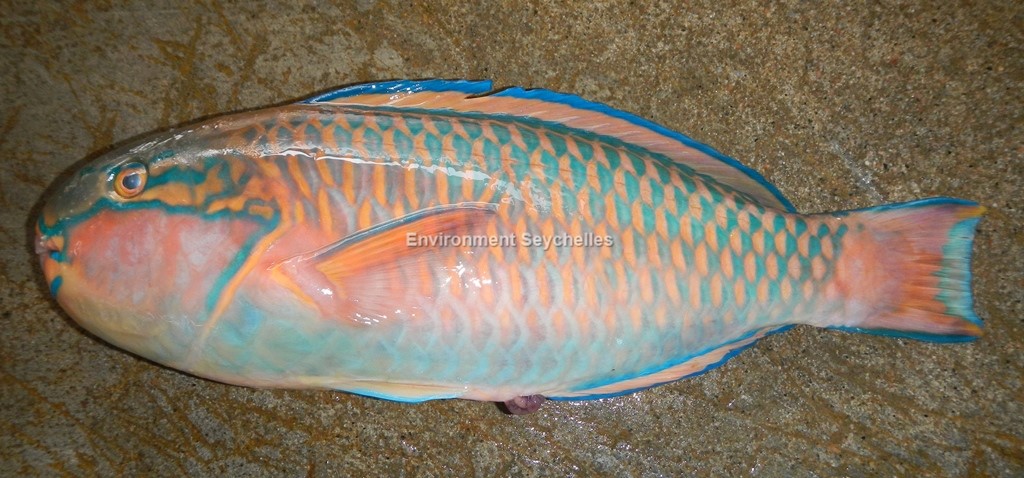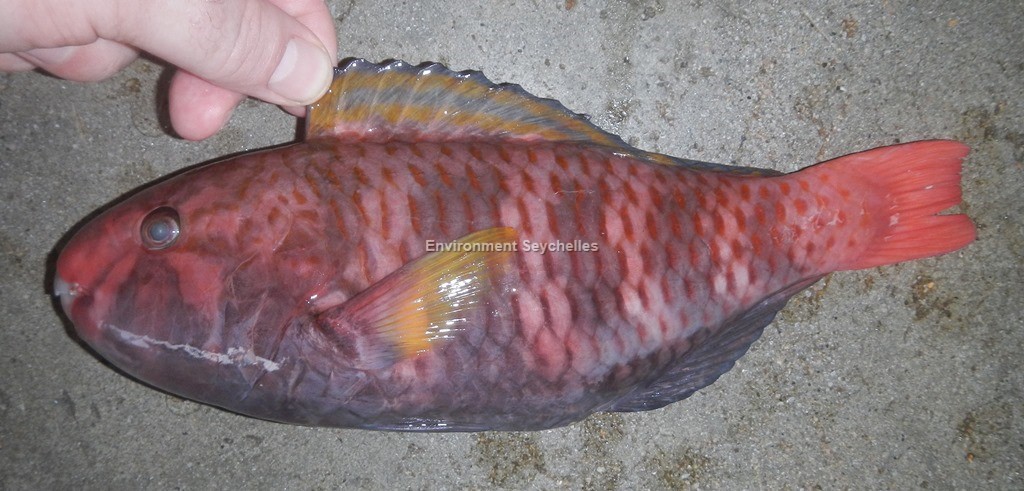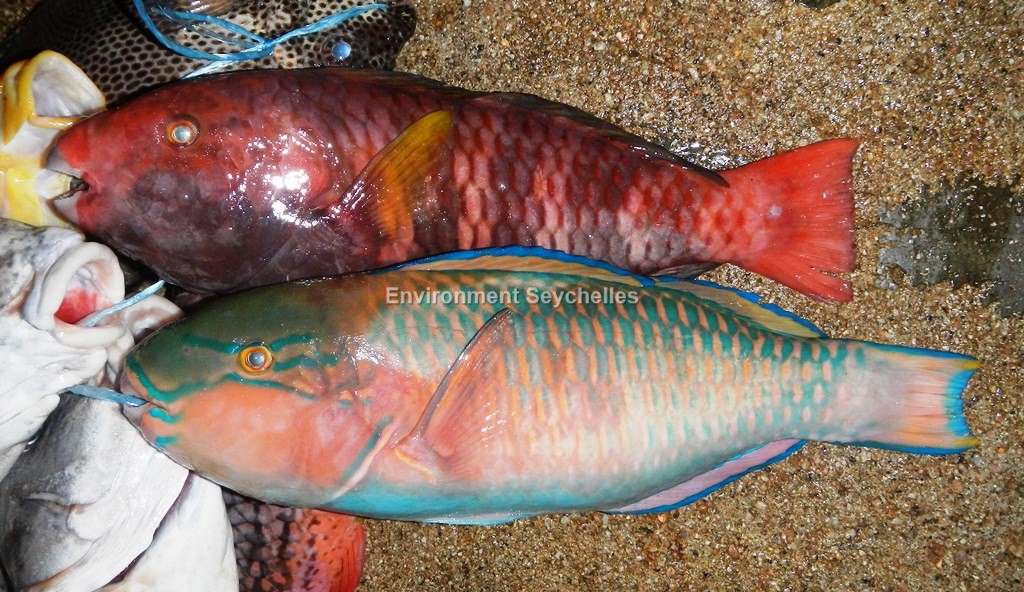Description:
Small to meidum-sized parrotfish. Head bluntly rounded in profile. 2 rows of scales on cheek, (upper with 6 or 7, lower with 6-8 scales). Dental plates
broadly exposed with 1-3 posteriorly inclined canine teeth on side at rear of upper dental plate. Caudal fin of initial phase slightly rounded; truncate
to slightly emarginate in terminal phase.
This species exhibits a complex colour pattern that is summarised here with a detailed description below, derived from Randall & Bruce (1983).
Initial phase: reddish brown body with 4-5 pale bars on flank, snout paler red. Yellow pectoral fins. Dorsal fin yellowish with blue-grey margin and
median stripe. Caudal fin pale red/pink.
Terminal phase: blue green body with pink bars on each scale, broad pink band on operculum, blue green bands on head and pale caudal fin.
Detailed description:
Initial phase: body reddish brown with a brownish orange bar on each scale anteriorly, the bars becoming shorter posteriorly, ultimately forming spots on
caudal peduncle. 4 pale pinkish bars on body, the scales in the bars retaining their brownish-orange bars. Rear half of caudal peduncle and all of caudal
fin pale salmon-pink. Head reddish brown, the snout and diffuse broad bands radiating from eye light brownish-red. Dental plates pinkish white. Dorsal fin
dull orange with a bluish grey margin and median longitudinal band. Anal fin brown with bluish grey margin. Pectoral fin rays yellow becoming brown
basally, the membranes pale, the base brownish red. Pelvic fins brown.
Terminal phase: body blue-green with a salmon pink bar on each scale, bars shortening posteriorly to oval spots on caudal peduncle. Abdomen and thorax
pale blue-green, becoming pale salmon ventrally. Head blue-green dorsally with narrow blue-green bands as follows: one dorsally on upper lip to corner of
mouth, thence almost to eye where it passes horizontally under eye to opercular flap, then angling ventrally submarginal to edge of operculum; a second
band from snout in front of upper edge of orbit, through dorsal part of eye and extending dorsoposteriorly; an irregular third band extending posteriorly
from behind centre of eye. Blue-green band across chin to behind mouth. Cheek below horizontal blue-green band abruptly pale salmon-pink; dental plates
white with a faint lavender cast. Dorsal and anal fins salmon to yellowish with broad turquoise borders and a narrow turquoise band at base. Caudal fin
salmon with turquoise upper and lower borders and a broad crescent light blue posterior border. Pectoral fins with upper edge bluish, then a broad zone
of salmon faintly streaked with dusky purplish, becoming pale on lower half of fin. Pelvic fins with light salmon to yellowish rays and pale membranes,
the lateral margin faintly light bluish.
Size:
Maturity: Lm unknown. Range unknown. Max Length: 40 cm TL.
Habitat and Ecology:
Inhabits reef flats to outer and coastal reef slopes (depth 2-20 m) favouring coral and algal habitats. Solitary or in small groups, females tend to form
small groups. Oviparous, distinct pairing during breeding.
Fishery Status:
This species is not protected or subject to fishery regulations. It is caught in the fish trap fishery, but is a relatively uncommon component of the
catch. Catch monitoring indicates the species is more common around certain more isolated islands on the Mahe Plateau.
Notes:
Very similar in appearance to Chlorurus atriluna which has also been cited as occurring in Seychelles (Bruce & Randall 1984) but has yet to be noted in
the artisanal catch in a 2013-2020 survey – pers obs. The Initial phase for both species is very similar but front of snout of C. atriluna is solid
brownish red. The Terminal phase of C. atriluna has a black crescent on the caudal fin.
References:
Bray, D. J. Chlorurus capistratoides in Fishes of Australia, http://fishesofaustralia.net.au/home/species/4934 (12/03/19).
Bruce, R.W. & Randall, J. E. (1984). Scaridae. In W. Fischer and G. Bianchi (eds.) FAO species identification sheets for fishery purposes.
(Western Indian Ocean fishing area 51). Volume 3. FAO, Rome.
Choat, J.H. et al. (2012). Chlorurus capistratoides. The IUCN Red 2012: http://dx.doi.org/10.2305/IUCN.UK.2012.RLTS.T190697A17791209.en. (12/03/19).
Froese, R. & D. Pauly. (Eds.) (2019). FishBase. https://www.fishbase.se/summary/25677 (12/03/19).
Lieske, E. & Myers, R. (2002). Coral Reef Fishes. Indo-Pacific and Caribbean. Revised edition. Princeton University Press. ISBN 0-691-08995-7
Randall, J.E. & Bruce, R.W. (1983). The Parrotfishes of the Subfamily Scarinae of the Western Indian Ocean with Descriptions of Three New species.
Ichthyological Bulletin of the J.L.B. Smith Institute of Ichthyology. Number 47 March1983 ISSN: 0073-4381
Citation:
Nevill, J.E.G. (2019). Chlorurus capistratoides, Indian parrotfish. Seychelles Seatizens. www.seatizens.sc. https://seatizens.sc/species/chlorurus-capistratoides-bleeker-1847/ (edited 14/08/22).




There are no comments